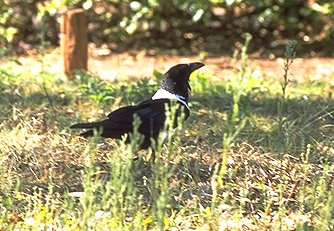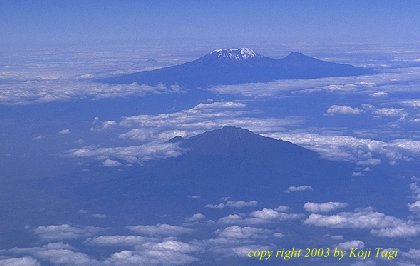
Böhm's Bee-eater, Liwonde National Park
Malawi Travel Report
July, 2003

Böhm's Bee-eater, Liwonde National Park
After I got a present position, I have obtained
more opportunities to go abroad as a part
of my work. I had never had an opportunity
to visit Oman and Uganda without working
in the organisation.
My mission for this time was in Malawi. Malawi
is located in southern Africa, west of Mozambique
and south of Tanzania. Lake Malawi, located
in northeast of the country, dominates about
20% of the territory. Malawi is probably
the poorest country among the countries where
I visited in the past. Comparing to the neighbor
country, such as Zambia and Tanzania where
lots of tourists visits for Victoria Fall
or safari, Malawi is still a minor destination
for the tourists.
On July 15, my trip was stated from Narita.
Even it is already middle of July, climate
is still cold and wet in the eastern Honshu
in this year. Although the SARS panic was
already settled down, the airport was still
extremely less busier than before. At 18:00,
our flight, JL 711 left Narita to Singapore.
In Singapore, we transited for SQ 406 to
Johannesburg. Comparing to Singapore Airline,
JAL's service is obviously inferior. Although
the Japanese company prioritises gracefulness
of flight attendants, they should rather
upgrade the poor option of drinks, foods
and music channel since they charge expensively.
Johannesburg, was larger and more modernised
airport than my imagination. Some shops sell
African wildlife goods which may be attractive
for foreigners. After a flight of South African
Airways, we finally arrived in Blantyre,
Malawi. The airport was so small. Immigration
counter was so small with only four temporary
desks.
Since the country is in the dry and cool
season, out of the airport was a sandy colour
world. For preventing soil erosion, fast
growing eucalyptus has been planted (even
now!) widely in the country. Since most of
the trees on the way to Blantye are eucalyptus,
I thought we were in Australia!
July 17
First date for the field survey. It was a
cold morning. After having breakfast, we
left the hotel at 8:30. The road toward Lunzu
was good condition. After picking up a counterpart
in the town, we went into a minor road, which
was unsealed and dusty....
Even in the country field, there are very
few birds. I saw some Common Fiscals but
nothing else much. Some finches, such as
cordon bleu, Red-billed Quelea, Yellow-fronted
Canary were seen near the river or farms.
Chestnut-breasted Rock Bunting, which is
similar to House Bunting, was also one of
the common species in the region.
In Africa, somehow, kids show their interests
to strange Japanese visitors. Our car was
always followed by lots of kids in the day.
They showed very nice smiles and screamed
something to us.
After visiting five villages, we dropped
in a market in Lunzu. Surprisingly, Malawi
is a rice-producing country. It is sold 35
kw/kilogram (approx. US$0.4). From the market,
it was not easy to imagine that Malawi has
often suffered from famine in its history.
Malawi's real problem is probably originated
from the British colonial era. Since, Malawi
has been still continuing mono-cultural type
agriculture with tobacco, tea and coffee,
local people have been often suffered from
famine. While the commercial products are
planted in better-conditioned lands, how
local people are able to survive with remaining
poor soil lands?
July 18 - 19
As July 17, we visited several villages for
monitoring the progress of the pilot study.
In some villages, farmers have cooperated
each other for clearing lands for a new farm.
Surprisingly, at least in this district in
the country, people rarely cooperate each
other as communal work.
Around the villages, some see-eating passerines
were seen. Those include Southern Red Bishop,
Southern Cordon-Bleu, Red-billed Quelea and
Yellow-fronted Canary. Cinnamon-breasted
Rock Bunting is also commonly seen throughout
the district.
In Malawi, cars are imported from Dubai.
However, they are not manufactured in UAE
but originally exported from Japan. Those
cars are mostly bargained cars since they
are too old to sell in Japan. Some of the
cars still show some evidences, which were
used in Japan. In the side of a car, there
was an advertisement of a kids ware company
in Osaka. I wondered whether the company
still remains or not since the economic situation
is Japan has been so bad for this decade.
July 20

A free day of the mission. We decided to
go to the Liwonde National Park, located
in northeast of Zomba. The national park
is a premier spot for game species as well
as birds in Malawi.
A driver came to our hotel at 7:30 a.m. in
the morning. We headed toward north to Zomba,
then after passing through town of Liwonde,
we turned left to the national park. After
crossing through the boundary of the park,
the dry open field was changed to dense bush
country. It is so obvious the park is protected
from human use in the good condition.
In the front of us, we found a large group
of animals. There were about 20 of Waterbuck
on the roadside. As we were able to arrive
at the park in the morning, we were able
to see some mammals, such as Greater Kudu,
Impala and Warthogs.
Along the road, Southern Cordon-Bleu were
commonly seen while we were impressed with
Eastern Paradise Whydah with the long tail
of the male and Lilac-breasted Roller's stunning
colour.
From the Mvuu Lodge, we rode a boat to the
Shire River. Shire River is a part of
Zambezi River, which goes through to Zambia
and Namibia. The national park is famous
with hippopotamus. Within ten minutes, we
found first hippos in the river. They showed
their noses and eyes on the water. Hippos
were certainly very common along and in the
river. From a long distance, they look like
large rocks! Red-billed Oxpecker and Cattle
Egret sometimes sit on the back of the hippos.
The former species pick up insects from the
hippos body while the latter simply wait
for insects fly off with hippo's walk.
On the boat, Wire-tailed Swallows (photo
right) build their nests. The elegant swallow
has a long elongated tail. Pied Kingfishers
were flying on the riverside while a Malachite
Kingfisher sits on the reed quietly.

Nile Crocodiles were well camouflaged on
the riverbank. Unless it does not move, they
are just like dead trees. An even larger
creature, African Elephant, was also seen
along the river. The huge animal has had
white spots on the back. Those must be painted
by birds, such as Cattle Egret.
After enjoying the boat for two hours, we
came back to the Mvuu Lodge and had lunch
there. Around the lodge, I noticed orange
and green birds were sitting on the tree
near the lodge. They were Bohm's Bee-eater.
The brightly coloured bee-eater is so tame
and easily approached to close.
A Collared Palm Thrush was in the bush but
was a very curious bird. It came out immediately
from the bush when we squeaked.
Other highlights in the park were large and
bright colored Purple-crowned Turaco, which
has rounded red wings and entirely greenish
body with glossy purple crest. A Green Wood
Hoopoe was sitting on the dead tree. The
characteristic shape with the red bill was
so impressive.
At 3:00 p.m., we left the national park to
go back to Blantyre. On the way to go back,
Mike, a guide of the tour company, told us
price of the car is terribly expensive in
Malawi. He said that a Toyota CAMRY, which
was over 200,000km with over ten years old,
is about 450,000 kw (approx. US$ 5,000)!
Most of the cars are obviously imported from
Japan via somewhere else, such as Dubai.
The cars are probably traded by Indian businessmen.
In another side, local governments of Japan
have been suffered from scrapping old cars,
because so many cars are currently left in
the field. It would be more helpful for African
people if Japanese government is able to
export (with reasonable price as in Japan)
the cars....
From July 21 to 23, we mainly spent our time
for meetings. Since the buildings of our
counterpart reminded me my university in
Australia, inside of the buildings were actually
cold as my uni, too.
On July 23, we moved from Blantyre to Lilongwe
to report in our office. Our flight from
Blantyre was delayed with fog in the morning
in Lilongwe and changed to a smaller one
with for only 12 passengers.
The Lilongwe Airport is an ordinary airport.
As the Blantyre's one was so small, we predicted
about the same size.
After droppied in the office in Lilongwe,
we went to our hotel, Korean Garden Lodge.
The hotel is compact but is neat with relatively
budget price ($40/night).
As the name indicates, the hotel has a fairly
big backyard. There were Fork-tailed Drongo,
Scarlet-chested and Variable Sunbird, Southern
Cordon-Bleu and Yellow-fronted Canary in
the garden.
July 24 - 26 Lilongwe - Nairobi - Dubai - Bangkok -Narita
A cold morningc. Unlikely the last afternoon, there were very few birds in the backyard. Some brown finches were chattering in the bamboo thicket. With the red rump and bill, they were identified as Red-billed Firefinches.

After 9:00 a.m, we headed toward the Lilongwe Airport. Since we had plenty of time in the airport, I spent time for taking photos of birds. It was lucky for me to take some shots of Scarlet-chested (photo right) and Variable Sunbirds.
At 10:30, the Kenyan Airways opened their gate. We left our baggage to be transferred to Bangkok directly. At the lounge, a middle aged big lady was sitting. She looked so boring. After she served a cup of tea to us, she suddenly started singing. It must be a kind of service in the lounge.
Our flight to Nairobi left as the schedule. On the flight, we enjoyed a dynamic view of Mt. Kilimanjaro.
We arrived at Nairobi as the schedule. Transit at Nairobi was bit troublesome. We needed to receive our boarding pass at the gate. Since the Emirates staff was not familiar with computer, we waited for more than 30 minutes to do it.
 Our flight to Dubai was nearly full. Actually, Emiratesfs service was more than
average, I was not so impressed with it since
the Singapore Airlinefs service was more
comfortable for me.
Our flight to Dubai was nearly full. Actually, Emiratesfs service was more than
average, I was not so impressed with it since
the Singapore Airlinefs service was more
comfortable for me.
At Dubai, we got off for another transit. Dubai International Airport is a modern and crowded airport. It would be one of the busiest airport in the worldc. I was fed up with meals on the airplane. So, I did not taking it on the flight to Bangkok.
At Bangkok, I was informed my baggage was missed at Dubai. Fortunately, the Emirates staff found it at Dubai and arranged to send to Japan one day after my schedule.
At 6:15 on July 26, I finally came back to Japan after spending 1.5 days from Lilongwe. Malawi would be the most inconvenient destination for me. However, there were lots of things for me to learn and seec.
On the announcement of a train from Narita, I heard there was a big earthquake in Sendai. As the monsoon season has not finished yet, I imagined the damage would be significant.
Unlikely my prediction, Japan was still in
the rain, but hot summer will be here soon.
